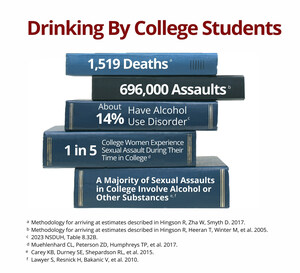Risky Drinking Can Put a Chill on Your Summer Fun
News provided by
National Institute on Alcohol Abuse and Alcoholism, National Institutes of HealthJun 25, 2018, 11:09 ET
BETHESDA, Md., June 25, 2018 /PRNewswire/ -- Summer is a wonderful time for outdoor activities with family and friends. For many people, a day at the beach, on the boat, or at a backyard barbecue will include drinking alcoholic beverages. But risky drinking and summer activities don't mix. Drinking impairs both physical and mental abilities, and it also decreases inhibitions—which can lead to tragic consequences on the water, on the road, and in the great outdoors. In fact, research shows that up to 70 percent of all water recreation deaths of teens and adults involve any use of alcohol.1
Swimmers Can Get in Over Their Heads
Alcohol impairs judgment and increases risk-taking, a dangerous combination for swimmers. Even experienced swimmers may venture out farther than they should and not be able to make it back to shore, or they may not notice how chilled they're getting and develop hypothermia. Surfers could become over-confident and try to ride a wave beyond their abilities. Even around a pool, too much alcohol can have deadly consequences. Inebriated divers may collide with the diving board, or dive where the water is too shallow.
Boaters Can Lose Their Bearings
According to research funded by the National Institute on Alcohol Abuse and Alcoholism (NIAAA), alcohol may be involved in 60 percent of boating fatalities, including falling overboard. And a boat operator with a blood alcohol concentration (BAC) of more than 0.1 percent2 is 16 times more likely to be killed in a boating accident than an operator with zero BAC.3 According to the U.S. Coast Guard and the National Association of State Boating Law Administrators, alcohol can impair a boater's judgment, balance, vision, and reaction time. It can also increase fatigue and susceptibility to the effects of cold-water immersion. And if problems arise, intoxicated boaters are ill equipped to find solutions. For passengers, intoxication can lead to slips on deck, falls overboard, or accidents at the dock.
Drivers Can Go Off Course
The summer holidays are some of the most dangerous times of the year to be on the road. When on vacation, drivers may be traveling an unfamiliar route or hauling a boat or camper, with the distraction of pets and children in the car. Adding alcohol to the mix puts the lives of the driver and everyone in the car, as well as other people on the road, at risk.
Dehydration Is a Risk
Whether you're on the road or in the great outdoors, heat plus alcohol can equal trouble. Hot summer days cause fluid loss through perspiration, while alcohol causes fluid loss through increased urination. Together, they can quickly lead to dehydration or heat stroke.
Stay Safe and Stay Healthy
When alcohol is involved, summer will end but consequences can endure. However, you can have fun in the sun and still be safe. Avoiding alcoholic beverages while piloting a boat, driving a car, exploring the wilderness, and swimming or surfing is a good place to start. And if you're hosting a party or gathering, be sure to:
- Offer a variety of nonalcoholic drinks.
- Provide a variety of healthy foods and snacks.
- Help your guests get home safely—use designated drivers and taxis.
- If you are a parent, understand the underage drinking laws—and set a good example.
So What's in That Drink, Exactly?
Summer cocktails may be stronger, more caloric, and more expensive than you realize. You may be watching what you eat so you can fit into those summer clothes, but watching what you drink can keep you safe. NIAAA's alcohol calculators can help you assess calories, drink size, alcohol spending, blood alcohol levels, and the number of standard drinks in each cocktail.
Visit https://www.rethinkingdrinking.niaaa.nih.gov/tools/calculators/Default.aspx
Be smart this summer—think before you drink, and make sure that you and your loved ones will be around to enjoy many summers to come.
For more information on preventing problems with alcohol this summer, and tips on cutting back, visit: https://www.rethinkingdrinking.niaaa.nih.gov
1 Driscoll, T.R.; Harrison, J.A.; and Steenkamp, M. Review of the role of alcohol in drowning associated with recreational aquatic activity. Injury Prevention 10:107–113, 2004.
2 An adult male of average weight (196 lbs) would reach a BAC of 0.1 percent after drinking 4 or 5 drinks in an hour.
3 Smith, G.; Keyl, P.; Hadley, J.; et al. Drinking and recreational boating fatalities: A population-based case-control study. JAMA 286:2974–2980, 2001.
SOURCE National Institute on Alcohol Abuse and Alcoholism, National Institutes of Health
WANT YOUR COMPANY'S NEWS FEATURED ON PRNEWSWIRE.COM?
Newsrooms &
Influencers
Digital Media
Outlets
Journalists
Opted In





Share this article